To read about earlier or later segments of my John Muir Trail thru-hike, use the navigation links below.
For trip planning information, please refer to the JMT Alternate Beginning post.
Ascent to Evolution Lake
August 3, 2017 | 17.1 mi | +4100 ft / -1100 ft | View On Map
My watch alarm beeps annoyingly at 5:30, alerting me that it’s time to get up. I groan and begin the process of extricating myself from my sleeping bag. When it’s chilly, like it is this morning, I like to sleep with the hood cinched down to a small hole, just large enough to breathe through. It’s nice and cozy, but then I have to find the cord to loosen the hood and locate the zipper, all while mummified in the goose-down bag… sometimes the process can take a few minutes.
I stumble out of my tent, groan again as I articulate my stiff joints, and shuffle off for a morning bathroom break. I’m up early today so I can reach MTR as soon as possible to maximize the amount of time my battery pack has to charge. I want it charged as much as possible so that I can recharge my camera over the next 8 days as I hike the second half of the John Muir Trail.
I skip breakfast for now and instead pack up camp and start walking. It’s only a 2-mile walk, and I soon arrive at the front gate. It’s closed, but not locked, so I swing it open and walk into the ranch. There is a small area set aside for thru-hikers where we can retrieve our resupply buckets and relax a bit. On a bench beneath a bulletin board of announcements and weather forecasts is a red plastic box. Inside is a power strip, red light pulsating to indicate it is powered up. I fish the battery pack out of my bag and plug it in before retreating to a nearby bench and taking in my surroundings.
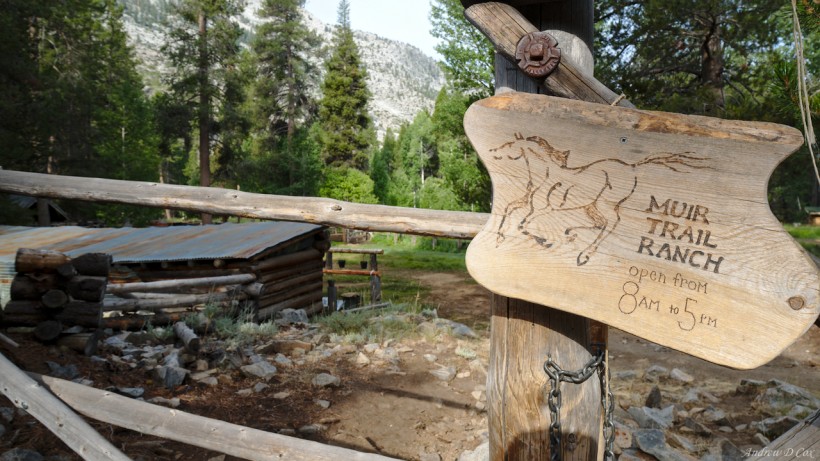
It’s very quiet; all the guests must still be sleeping or just rolling out of bed. I walk over to the bulletin board again and read the weather forecast: a chance of thunderstorms every day on the 10-day forecast. How very unhelpful, not to mention untrustworthy. Can they really predict the weather up here in the mountains? It seems like the weather is too sporadic and chaotic to make accurate predictions.
I return to the bench and mix up some oatmeal with cold water. It only takes about 30 minutes to rehydrate and I really don’t mind eating it cold, particularly because the hydrated chia seeds and oats have a delicious pudding-like consistency. While I’m waiting for the oatmeal to soak up the water, a ranch staff member passes by. She offers to retrieve my resupply bucket once she’s run the horses through to their pasture. I’m in no hurry and tell her to take her time. I enjoy watching the horses snort and stomp around as the woman and several dogs choral them into their daytime pasture.
Once the horses are taken care of, the woman – Hillary – returns and asks for my name so she can find my bucket among the stacks that are stored in the stone shed. Upon hearing my name she remarks, “Oh! You’re on the waiting list; I have a tent-cabin for you!” Mildly amused, I explain that I’m not staying here tonight. I would have loved to have received an email that I’d been pushed to the top of the waiting list. I could have spent the night here and had someone else cook my breakfast! Oh well – staying at MTR is expensive, so I saved myself some money by camping.
After fetching my bucket, Hillary leaves to take care of other chores and I set about organizing my resupply. About a month ago I packed all my food for these next eight days into an orange 5-gallon Home Depot bucket and then mailed it to the Lakeshore post office. For a fee of $80, the folks at MTR drive the bucket up to Florence Lake, ferry it across the lake via boat, and then carry them to the ranch on a mule train. They can essentially charge whatever they want; MTR is by far the most convenient resupply location for the next 110 miles.
I unpack the bucket and count the different packets: 8 breakfasts, 8 lunches, 16 snacks, 7 dinners… looks like I didn’t forget anything! I also shipped an entire package of mint Oreos, and I empty two sleeves into a ziplock bag and place the rest of the package in one of the hiker bins next to the shed so that other hikers can enjoy the spoils. I sift through a few of the bins myself and pull out some energy bars to supplement my supply. I have a tiny bit of room left in my bear can for them, and they’ll come in handy on those days when I’m extra hungry. I’ve already had the pleasure of hiking hungry on this trip and would like to avoid repeat occurrences if possible. With food for seven days, the canister is full to the brim. I don’t have to fit today’s food in the canister because I’ll eat it all today!
With my bear canister restocked, I add my now empty resupply bucket to a pile behind the shed and sit down to wait while my battery pack shuffles electrons around. Elizabeth Wenk’s JMT guidebook is sitting on a nearby table, so I retrieve it and begin reading. It’s a wonderful read, but I don’t make it very far before other hikers arrive. This crew is mostly PCT thru-hikers, some heading north, others heading south. I chat with them for a little while as they pull some goodies out of the hiker bins. I’m mostly interested in their reports from the southern passes and make mental notes as they share their stories.
By the time 8:30 rolls around, I’m ready to get going. However, before leaving I haul my pack over to a scale hanging from the shed and measure the weight: 36 pounds! That’s lighter than I expected, but it’s much heavier than my pack has been so far on this trip. I have a lot of miles ahead of me, so we’ll see how things go with all this new weight to lug around.
I bid farewell to the PCT hikers and begin my trek back to the JMT. Walking requires a noticeably larger effort, particularly on the uphill stretch out of MTR. Thankfully, the trail is flat for the next several miles and I soon grow used to the increased weight. It’s a beautiful morning: the sun is shining, a few wispy clouds dot the sky, and a gentle breeze blows through the dry grass at my feet. I pause my march only to capture photos when a particularly breathtaking composition presents itself.
Only a few miles past Muir Trail Ranch, I reach Piute Creek and the border of Kings Canyon National Park. I’m not sure which canyon(s) the park is named for, but this one is certainly kingly! The granite walls tower thousands of feet above my head, with gray walls covered in green trees and the occasional white brushstroke of a waterfall cascading down from some hidden snowfield. I continue along the rocky trail with the San Joaquin on my right. Two of the PCT hikers I met this morning, Rosy and Pacer, catch up to me when I pause for one of my frequent photo ops. We exchange a few words and they continue past me; they’re trying to make it up and over Muir Pass, several miles further than I’m planning on walking today.
The path alternates between heavily wooded sections and exposed rock near the river. I’m walking only slightly more slowly than Rosy and Pacer, and I catch up to them whenever they pause to admire the views or refill their water bottles. It’s fun to see the same people repeatedly, and I particularly enjoy being able to frame a few photos with them in the composition to lend a sense of scale.
Although the trail is gaining altitude, the slope is slight and the miles slip by. Before I know it, I cross the San Joaquin for the last time on a sturdy bridge. The river is much smaller here above the intersection of the San Joaquin and Evolution Creek. On the other side of the river, the path guides me back toward that intersection.
Soon thereafter I begin to climb up a series of steep switchbacks. I can hear Evolution Creek roaring on my left, though it is hidden from sight deep in a canyon. I huff and puff up the trail, pausing at every other switchback to catch my breath. Eventually, the switchbacks end, but the trail continues to climb. Evolution Creek comes into view when I reach the mouth of Evolution Valley; the water foams and froths as it careens towards the canyon behind me. The trail will cross this creek in the next mile, and the ford is infamous for being a difficult wade regardless of the snowpack. With the record-breaking snow levels this year, I expect the crossing will be deep and swift. Luckily, there is an alternate crossing further up the valley where the water is supposedly slower.
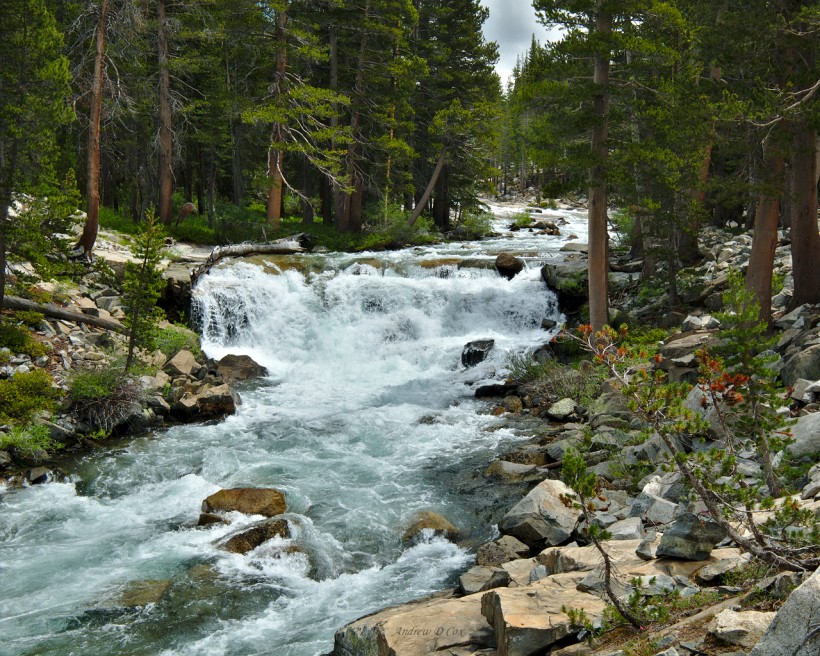
When I reach the official Evolution Creek ford location, I find Rosy’s pack propped up against a tree. He appears out of the woods while I’m surveying the scene in front of me. The water directly between the trail looks deep but, just 20 feet upstream, the water is shallower and forms little peaks as it tumbles over the rocky riverbed. Pacer arrives only minutes later; I’ve already made up my mind to cross here. The strong current pulls at my legs and trekking poles as I slowly wade toward the opposite bank. In the middle of the river, the water comes up to the middle of my thighs but doesn’t rise any higher. I nearly lose my balance once or twice but manage to remain upright. When I reach the opposite bank, I turn downstream and wade down to the trail where there is less brush to contend with.
Pacer and Rosy follow the same route and make it across without any issues. I say goodbye as they trudge down the trail in their wet shoes and I put my shoes and socks back on. With cozy, dry feet, I begin hiking again. The Evolution Creek crossing is probably the biggest challenge I’ll face today; all the other creek crossings should be manageable, and I don’t have a pass to traverse.
When I reach the next crossing, I hop from rock to rock, confidently moving toward the opposite bank. My smug attitude evaporates when I lose my balance for a moment and both of my feet slip off a rock into the shin-deep water. So much for dry feet!
I squish up the trail for another half-mile and stop for a lunch break on a sunny granite boulder. I wring out my wet socks and shoes and hang the socks from a small pine tree while I chow down on peanut butter, a tortilla, and dried fruit. Oh, and don’t forget the Oreos! Although lunch is quite satisfying, my short break is not nearly long enough to allow my socks to dry, and I continue up the trail with soggy feet
Although lunch is quite satisfying, the short break is not nearly long enough to allow my socks to dry, and I continue up the trail with soggy feet. The trail winds gently upward and the valley begins to open up. I soon reach a beautiful campsite in a grove of pine trees. I can see a meadow and a river through the trees, so I put my pack down and walk over to investigate. I’ve heard from many people that Evolution Valley is breathtakingly beautiful, but I am not prepared for the view that greets my eyes. Directly in front of me is Evolution Creek. In contrast to the tumultuous flow I witnessed earlier, the water here is slow, smooth, and incredibly deep. Despite the depth, I can see all the way to the white sand bed below, which is littered with pine cones and twigs. The gently winding river creates a natural barrier between the forested trail and lush green meadows on the opposite bank. In the distance, a few deer are grazing on the long grass, completely unafraid of the humans passing by.
I rush back to my pack to grab my camera and then return to the riverbank to take a few photos. I wish the afternoon clouds would clear out; I would appreciate some sunshine to light up the landscape. I’m sure that, like the past three days, it will drizzle in the afternoon and then the clouds will clear out for sunset; I’m really looking forward to the evening light up at Evolution Lake!
As I walk past the McClure Meadow ranger station, I spot Rosy and Pacer relaxing by the cabin, probably having lunch. I smile, wave, and continue up the trail. There are several more meadows, small and large, further up the valley. A singular peak named “The Hermit” towers over one such meadow, and I step off the trail for a few minutes to take some pictures. With the wide 10-24mm lens, I can capture both the foreground and background in sharp focus. To take advantage of that properly, I’ve positioned myself so that a smattering of flowers provide foreground interest, with the meadow, trees, and the Hermit in the background. A rapid burst at multiple exposure lengths captures the full dynamic range of the scene; modern technology is amazing!
Satisfied with the image, I get up from my awkward position low to the ground (to get those flowers in the frame) and continue walking. I soon reach the top end of Evolution Valley and begin climbing a series of switchbacks. On the way up, I pass a middle-aged gentleman who is struggling to catch his breath. I’m breathing heavily as well, so I stop to talk to him for a few minutes. He’s traveling with his sons on a multi-day trip, just for kicks. The younger guys are ahead somewhere, hopefully setting up camp.
After a brief chat, I bid him farewell for the time being, and continue up the trail. The mountain vistas from the switchbacks get better with each turn and before long I find myself back in the sub-alpine zone. The final mile to the lake is one of the most beautiful sections of trail I’ve had the pleasure of walking this summer. There are small ponds dotting the landscape, with little patches of grass and scrawny pine trees growing amidst the granite. The clouds have cleared somewhat, and the afternoon sunshine brightens the landscape and my mood.
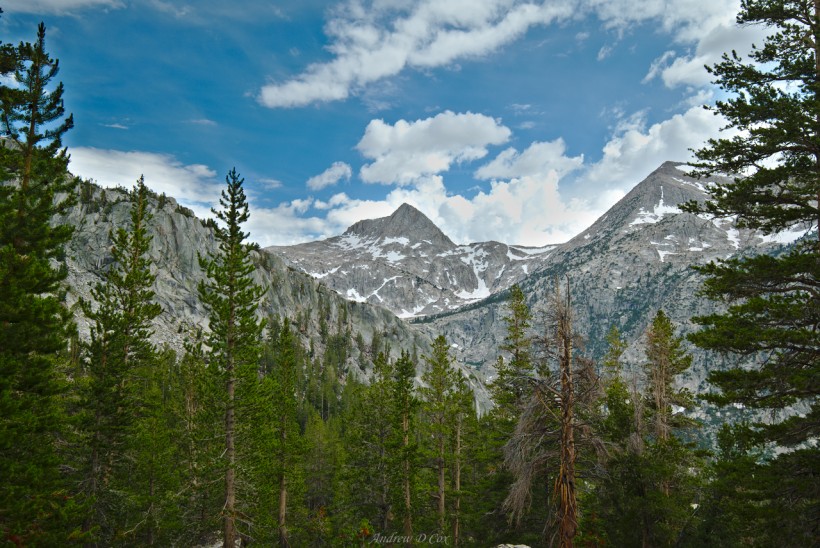
As I crest the final hill, an expansive view of Evolution Lake opens before my eyes. A small collection of tents are pitched on a sandy peninsula directly in front of me, and the trail winds around the lake to my left, cutting a tan furrow through the spongy green turf. I set my pack down on a slab of granite and stretch my arms and back; what a spot! I’ve walked quite far enough for one day, so I’m not really inclined to continue down the trail to find a campsite: the sandy peninsula looks just fine.
After some scouting, I find a patch of sand large enough for my tent and begin setting it up. A strong wind increases the challenge of erecting the lightweight shelter, but I manage with some creatively placed rocks. Staking out the tent also proves to be difficult because the sand is only a few inches deep on top of the granite. I manage to drive a few steaks into deeper soil but have to use a different method to secure the tent on three of the four sides. I pull the rope out of my pack, tie one end off to a heavy stone, and then work out how to tie the rope to each guyline. After a few minutes of trial and error, I devise a way to secure the guylines by tying the middle of the rope to each guyline. A few loops around large rocks keep the rope taut in each direction. It’s good that I went back for the rope yesterday; I would have had to move to a different campsite without it!
Pleased with my handiwork, I step back and admire the tent. Despite the stiff breeze and thin soil, I think it will hold just fine! I glance up at the surrounding peaks and notice something strange: the clouds that were high overhead an hour ago are now low enough to obscure the spires of Mount Mendel. The sight is really pretty cool, so I grab my camera and snap a few photos. The sun still shines brightly from the west, so I’m not too worried even though it is 4:00, about the right time for that daily afternoon shower.
With camp set up and plenty of daylight left, I wander around and meet my neighbors. The gentleman I passed on the switchbacks is camped nearby with his sons. One of them is interested in becoming an aerospace engineer (which is what I do!), so I chat with him for a little while. The father remarks that he’s seen this kind of weather before, with the low-hanging clouds, and last time it brought days and days of rain. I really hope that’s not the case; it’s hard to imagine such a sunny part of the country experiencing days of rain. Come to think of it, other than a few afternoon drizzles, I’ve never been seriously rained on during my past trips to the Sierras.

After chatting with several other hikers, I return to my tent and cook dinner. The food is delicious, and I savor a few M&Ms I saved from my afternoon trail mix for dessert. I stash all my scented items in the bear canister and shove it under a nearby tree. The warm, golden evening light should begin soon, although I’m beginning to wonder how much of it we’ll get up here at the lake. During the time it took me to rehydrate and eat my dinner, the clouds have continued to gather and descend down the mountain slopes. Even if the sun doesn’t make it up here to the lake, Evolution Valley might have a nice sunset!
I climb up a nearby ridge and find a decent spot with a west-facing view. The wide, sweeping curves of Evolution Creek are clearly visible amidst the trees and the lumpy gray clouds add a moody vibe to the whole scene. Once my camera is set up on the tripod and I have a nice shot framed, I wait for the light. To pass the time, I stretch each of the major muscle groups in my legs and lower back. A rigorous stretching routine is something new I’m trying this year. I’ve dealt with sore muscles and even overuse injuries in the past after long trips, and I’m determined to avoid those this time. Of course, sore muscles are guaranteed to a certain extent, but a lot of the pain can be mitigated with stretching.
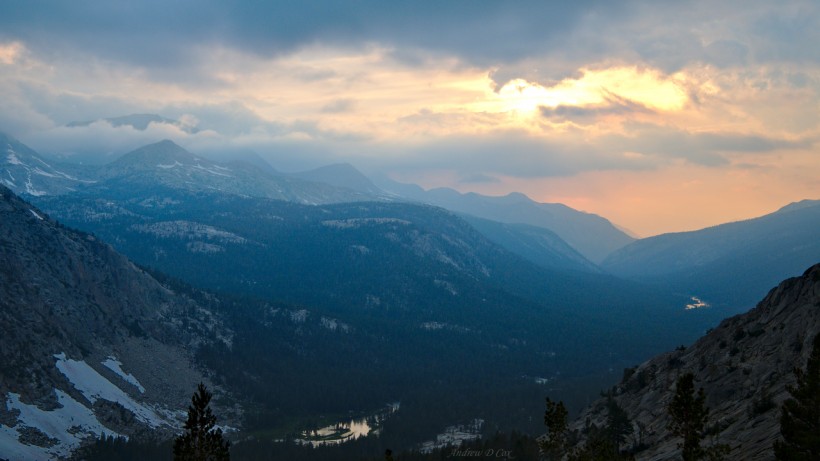
Unfortunately, the warm sunset light I’m hoping for doesn’t appear. The clouds are too thick, even low on the western horizon. I snap a few shots of the moody clouds flying past Mount Mendel and then pack up my tripod and sling my camera over my shoulder. As I descend off the ridge toward the sandy peninsula, a light drizzle begins. I pick up my pace; even though my camera is weather sealed, I don’t want it to get too wet.
I wonder what happened to Rosy and Pacer? I know they were planning to traverse Muir Pass, but I didn’t see them again today and they must have passed by here if they continued to the pass. Of course, they could have easily walked past without my seeing them. I hope they made it far enough down the pass to avoid any dangerous weather!
Once I’m safe within the shelter of my tent, I take off my shoes and socks, plug in my camera to recharge, and lie down. The patter of rain on the tent walls grows louder as darkness falls. I suppose I’d rather it rain now when I’m done for the day than when I’m out hiking! I spend a few minutes examining the map under the soft red light of my headlamp and then drift off to sleep as the rain and wind pummel the rainfly. I sure hope that rope holds.
Over the Goddard Divide
August 4, 2017 | 17.0 mi | +1600 ft / -4200 ft | View On Map
I wake up at 4:00 AM and instantly notice the silence: the rain and wind have stopped! I venture outside for a middle-of-the-night bathroom break and look around for stars but don’t see any. It must still be overcast. I sleep for a few more hours and get up when the sky begins to lighten. The first thing on my mind is the state of my gear: is any of it soaked? The rainfly is sopping wet, but everything else – my pack, sleeping bag, camera – is dry. Thankful for this stroke of good luck, I step out of the tent and survey the landscape. The sky remains overcast and the vista is a dreary one.
I take care to keep my dry gear from getting wet as I pack up. I stuff the sleeping bag into a waterproof stuff sack and, for extra measure, wrap the stuff sack in a garbage bag. My extra clothes live in their own garbage bag, so there’s no need to double up there. I shake out the tent as best as I can and then stuff the heavy, wet rain fly into another plastic garbage bag. That should prevent it from dripping onto my other gear until I can dry it out.
Of the group of campers on the sandy peninsula, I’m the first to begin hiking. It doesn’t look like there will be any nice sunrise light, so there’s no point lingering for photographs. I start down the trail and wind around the upper half of Evolution Lake. Thanks to the calm morning air, the water is mirror-like and reflects the distant snow-covered mountains. The grass is dripping with water droplets but the trail, which is just a thin strip of sand, remains fairly dry. Because of this lucky circumstance, my shoes, socks, and feet are still dry! It’s the little things that make my day.
At the Evolution Lake inlet stream, I’m faced with a choice: I can cross the 40-feet of ice-cold water and soak my shoes, or I can head upstream and find a location to hop across and preserve my dry feet. I’m not eager to walk in soggy shoes this early in the day, particularly since the sun shows no sign of appearing, so I choose the latter. The landscape on either side of the inlet is composed almost entirely of large granite slabs and it’s not difficult to move upward and search for better crossing options. I walk all the way up to Sapphire Lake before conceding defeat; there’s no way to cross the creek without wading. Rather than backtrack to the trail crossing location, I find a shallow area near Sapphire Lake and contemplate my options. I could try crossing barefoot to avoid wet shoes, but the riverbed is littered with jagged rocks and I don’t want to risk injuring my feet. Thus, with a sigh, I wade through the water and accept waterlogged shoes for the foreseeable future.
Past Sapphire Lake, I follow the John Muir Trail through half a dozen saturated alpine meadows. Snowfields lie scattered all around and their combined meltwater flows over every inch of the landscape. I splash through most of the water; it’s not like my shoes can get any wetter.
As I gain altitude, I catch up to several groups of hikers that have slowed as the snowfields grow to completely cover the trail. There is some doubt about where the trail lies beneath the snow, but it doesn’t really matter; the direction to Muir Pass is easy to see and a casual inspection of the map reveals which side of which lake we should be on. I follow a large group of young hikers for a little while and then take the lead to maintain a pace I’m more comfortable with. Most of the hikers fall behind but two of them are maintaining a similar pace and we strike up a conversation. Their names are Matt and Darby, and they are taking a break from their jobs at Yosemite National Park to hike this famous trail.
I enjoy chatting with them and soon forget (for the most part) about my wet feet and soggy shoes. Any lingering discontent is driven completely out of my mind when we round a bend and see Wanda Lake for the first time. Most of the lake is covered with large slabs of ice, but the exposed water is smooth as glass and mirrors the distant mountains. As we cross the outlet stream, I pause and take a few pictures in an attempt to capture the beautiful scenery.
My mood improves even further when I notice that the clouds have cleared a bit; I can see blue sky ahead! Some warm sunshine after last night’s long rainstorm would be fantastic. Matt and Darby had a much more difficult night than I did: Matt reports that the storm lasted until about 4 and he was only able to sleep for those few calm hours before sunrise. To make matters worse, their tent and sleeping bags are all uncomfortably wet.
After a pleasant stroll along the lake on a rocky trail, we reach the far shore and are faced with a new challenge. Stretched out in front of us is a mile of solid snow. Several sets of boot tracks lead across the white and pink landscape, so I pick one track and begin the long trudge toward Muir Pass. I can see the pointed roof of Muir Hut in the distance and trudge in its general direction. Walking in the snow is actually some of the easiest hiking I’ve done today! There are no rocks to trip over and no puddles or streams to avoid. The most challenging obstacles are sun cups, parabolic bowls of various sizes arranged in a sort of Voronoi pattern across the landscape. I step on the rims of the cups but occasionally misstep and slide a foot or two into the bottom of one. Each slide slows me down a little, but it’s kind of fun to slip around a bit. Plus, this water is in solid; it beats walking through the liquid stuff!
I reach the Lake McDermand inlet stream before my new friends and attempt to locate a ford that avoids wading. There doesn’t appear to be one, so I splash through the shallowest section I can find and re-soak my shoes. On the other side, the snowfield steepens for the final approach to Muir Pass. The sun cups are deeper here, so I exercise a bit more caution while stepping on their steep ridges. Crampons would be useful to avoid slipping, but they’re hardly necessary for safety. So far, I’m very happy with my decision to send them home and shave a few pounds from my pack weight.
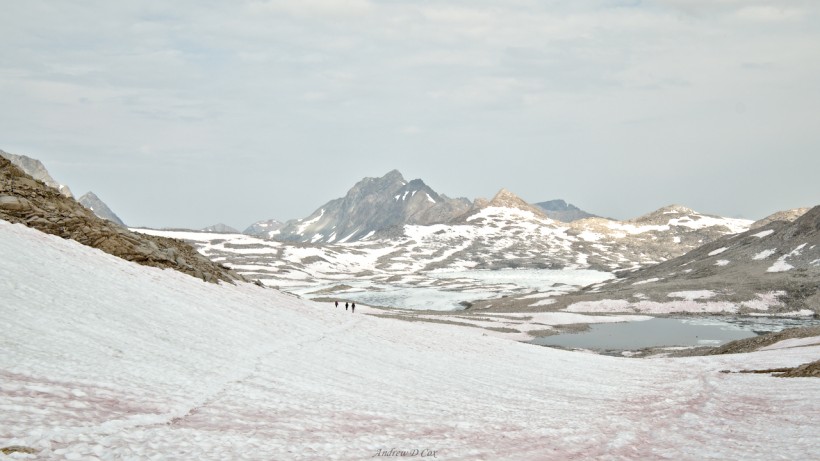
With the long, snowy trudge behind me, I stride up the last hundred yards through loose talus. At Muir Hut, I take off my pack as well as my shoes and socks and wiggle my toes around. You’d think it would be freezing up here with all the snow, but the temperature is very comfortable and wandering around with bare feet isn’t prohibitively cold.
I meander into the hut to check it out. The floor, walls, and ceiling are all stone, and only the doorway and a small window supply light to the interior. A wooden bench wraps around the circular edge of the hut, with a break on one side for the fireplace. The fireplace itself is blocked off, filled with stone and cement. It would be lovely to have a fire up here, but I suppose the local rangers don’t want to deal with irresponsible hikers. The air inside the hut is surprisingly musty and humid, which makes sense when I realize that the doorway is the only opening to the ambient air. A sign on the wall above the fireplace warns that “Camping is prohibited discouraged.” Some previous hiker vigorously scratched out “prohibited” and etched “discouraged” in under the old lettering.
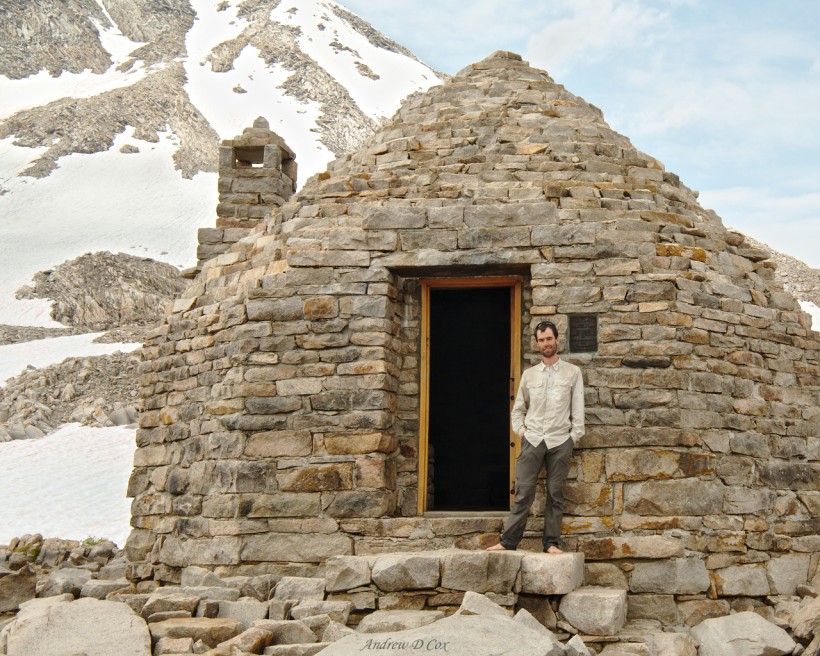
Matt and Darby reach the hut within a few minutes and check out the old stone structure. After a brief rest, we all begin the descent on the east side of the pass. From this high vantage point, all we can see is snow, ice, and rock. The soft snow makes the descent easy, particularly because we have very little route finding to do: just follow the boot tracks!
At the bottom of the first slope, I reach a dip in the snow and can hear water running. A few feet to my right, a hole in the bottom of a sun cup reveals a shallow stream gurgling through the rocks below. I step carefully on what appear to be the thickest parts of the snow until I reach dry land. From here, the next hundred yards of trail wind over a rocky island in the sea of snow; small cairns guide me, though it’s easy to identify the way once I spot the next furrow of boot prints in the snow ahead.
The lower we descend, the larger the streams become. I shudder to think what would happen if you fell through the snow into the deep, rushing water beneath. Needless to say, we avoid crossing on the snow bridges whenever possible. Of course, avoiding the snow bridges means wading through the icy creeks instead. I don’t bother even thinking about changing out of my hiking shoes anymore. They’re wet and will continue to be wet until we leave the snow behind.
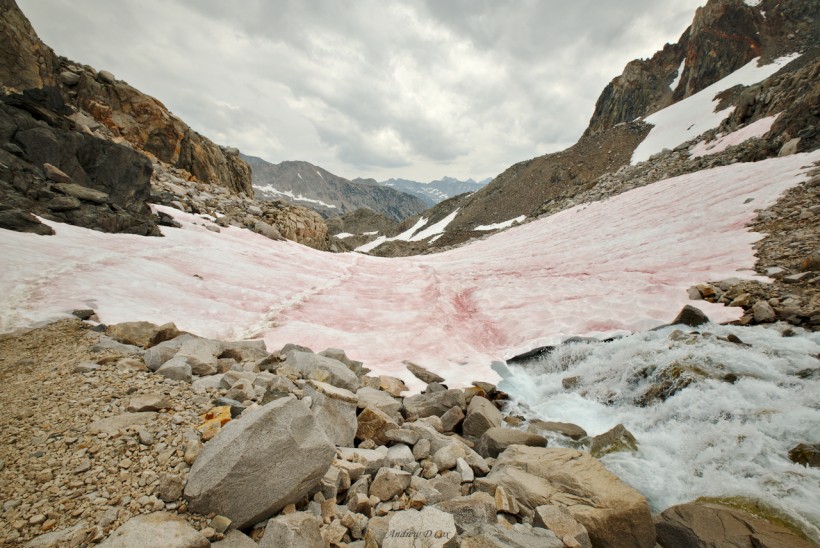
We continue to alternate between snow trekking and stream wading for an hour or so. One of the crossings includes hopping between submerged rocks (ankle-deep water) to avoid much deeper water (i.e., hip to shoulder deep). Despite my soggy shoes, I enjoy the scenic variety and the novelty of backpacking through such an inhospitable alpine environment. I’m happy that this year is a high snow year; the excess of water means that everything is still green and spring-like even though it’s August. I also appreciate the extra challenge!
As we reach lower altitudes, the snowfields occur less frequently but the stream crossings are more serious. Matt, Darby, and I reach a long horizontal traverse across a steep snow field and survey the surroundings. There is a glissade chute carved out in front of us… we might as well have some fun! Darby and Matt ski down on their feet, and I follow sliding on my butt. At the bottom, we clamber over boulders, splash through the inlet delta of a small lake, and then continue down a snow-free trail.
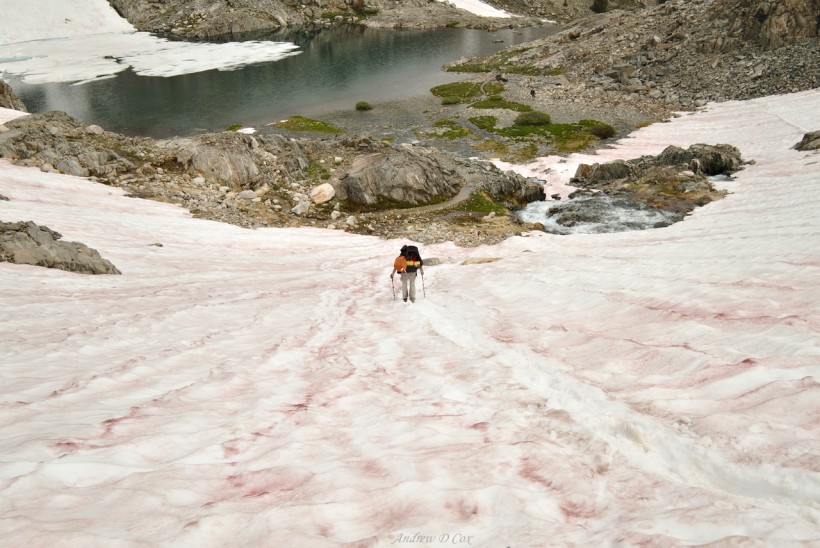
After only a few short steps on the trail, we arrive at the outlet creek. It’s just another wade at this point, though the water is rushing more quickly than most of our previous crossings. Oh, and freezing – you know the water is going to be frigid when you can see ice floating in the lake above…
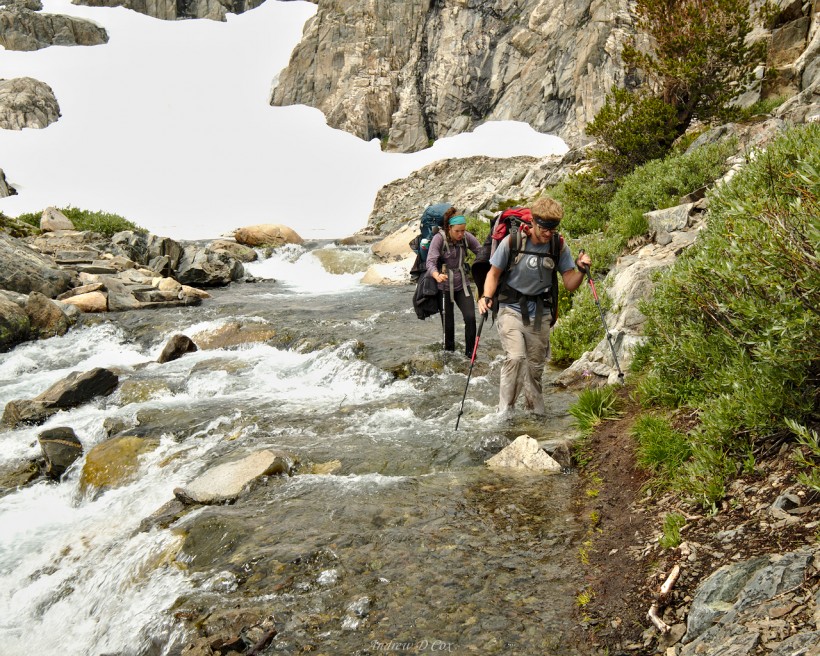
Past the outlet stream, we continue downhill. As we lose altitude, we encounter fewer and fewer snowfields on the trail. By the time we reach Lake 10330, just above Starr Camp, it seems like we’ve passed the bulk of the snow. It’s been a long morning and we’re all starving, so we stop for lunch on a relatively flat slab of granite just off the trail. Immediately in front of us, the trail begins switchbacks to descend into Le Conte Canyon and we’re treated to an expansive view of the trees and meadows below. I take off my shoes while eating and lay my socks out on the rock in front of me in the hopes that the meager sunlight streaming through the clouds will somehow dry them out.
Lunch is delicious – I finish off the last of my mint Oreos – but my socks are still wet when we resume hiking. There’s nothing I can do about that, but I hope they’ll dry as we descend into the snow-free canyon. Partway down the switchbacks, we turn a corner and come face to face with a “rock monster”; the face and mouth consist of a huge granite boulder that has split in two, and the teeth and eyes are made of smaller stones strategically placed by previous hikers. We pause to take a few pictures and, as we admire the beast, it begins to rain. The precipitation is gentle at first but soon grows to a strong downpour. We all pull on our jackets, and Darby and Matt slip rain covers over their packs before continuing down the trail.
Down in Le Conte Canyon, above Big Pete Meadow, the trail levels out and winds through a forest of tall pines. We cross several rivers where they transition from cascades to streams at the valley floor. Thankfully, the abundance of trees means that there are plenty of logs lying across the water and we’re able to cross without wading. I notice several backpackers hiding out beneath dense groves of pines to escape the rain. I suppose they might stay drier that way, but I’d rather walk. Trekking over wet trail certainly isn’t a new experience for me today, and there is no threat of lightning. Besides, the gray, wet day is sapping my happiness and I’m sure sitting around won’t improve my mood.
I walk a little faster than Matt and Darby do, and soon I’m alone as I trek through the woodland. I pass through a few sections of the forest that have been destroyed by some ferocious force: every tree has been uprooted and they lie flat across the trail. Trail workers have not yet been able to clear or cut through the mess, so I’m left to hop over the fallen timber.
I reach the Le Conte Ranger Station and wait for Darby and Matt to catch up. I’m not all that far ahead of them, so I don’t have to wait long. Together, we walk over to the ranger station, a small cabin with an even smaller porch. The ranger comes out when he hears us talking and answers our questions about the weather. He predicts the rain will last no longer than one or two more days; these “summer monsoons” are unusual and don’t last long. I sure hope he’s right; it will be hard to stay positive and enjoy the hike if it rains this much for the rest of my trek down the John Muir Trail!
After a brief chat with the friendly ranger, we continue down the trail. At his suggestion, we’re hiking to Grouse Meadows, touted as a gorgeous spot along the trail. We’re all well aware that “meadow” is synonymous with “mosquitos”, but… whatever. We’ll deal with them when we arrive.
Along the way, we meet a group of excited hikers that just crossed paths with a black bear. We keep our eyes peeled, but never spot the animal. As we hike along, Matt and Darby scope out neat climbing routes on the walls of the canyon. I’m not an experienced climber, but I grin as I listen to their enthusiasm.
It’s only a few miles to Grouse Meadows and we soon arrive at a pleasant campsite. There are a couple other sites nearby but this one is good enough, so we drop our packs and begin setting up camp. One of my first tasks is setting up a line between two trees. I hang my tent, wet socks, and other soggy gear on the rope and let them dry in the breeze for a while. Rather than squishing around in wet shoes, I walk around barefoot. I love the feeling of the soft pine needles beneath my feet!
Once we have camp set up, we build a small fire and bask in its warmth. Campfires are prohibited in Kings Canyon National Park above 10,000 feet, but we’re well below that altitude. The reason for this rule, we learned from the ranger this afternoon, is the scarcity of biodegradable material at high elevations. Apparently, the plant life relies on the decomposition of fallen trees and branches to survive; thus, if we burn the fallen wood, we deprive the ecosystem of valuable nutrients.
Although we don’t cook dinner over the fire (stoves are much more effective and don’t leave a sooty residue on the pots), we do cook our shoes. All of our footwear is soggy from the snow, the many river crossings, and the rain. We arrange them around the fire and watch as steam rises from the damp fabric. With any luck, we’ll have dry shoes for tomorrow!
The campfire lifts our spirits and we enjoy talking for the rest of the evening. Some of the rain-bearing clouds from this afternoon have cleared out and I spot a few patches of blue sky. I’m hopeful that the rain has run its course and the next few days will return to the standard dry, sunny Sierra weather.
The Golden Staircase
August 5, 2017 | 9.5 mi | + 3164 ft / -557 ft | View On Map
I wake in the morning to dry ground and a dry tent – what a pleasant change! After stumbling out of the tent, I catch a glimpse of Grouse Meadows to the south. Warm sunlight illuminates the east-facing slopes of the distant mountains and mist hovers over the meadow. The scene is surreal and breathtakingly beautiful. Naturally, I grab my camera and tripod and take several shots before returning to more practical matters like packing up camp and eating breakfast.
Once my morning chores are done, I say goodbye to Darby and Matt and head south. I wave as I pass our neighbors, Andrew, Emily, and another woman whose name I don’t know, just a few hundred feet down the trail. The John Muir Trail skirts the meadow and then follows the Middle Fork of the Kings River downstream. The transition from the slow, serpentine flow in the meadow to the frothing whitewater on the steeper inclines is astonishing! The river is peaceful and violent, both facilitating life and crushing boulders to sand.
It isn’t long before I reach the junction of the JMT with the “Middle Fork Kings River Trail”; what a long name! I walk east for a while, ascending toward the Palisades and their namesake lakes and creek. I’m taking it easy today and am only hiking nine or ten miles to one of the Palisade Lakes. It’s high time for a rest day and I’m excited to spend the afternoon and evening exploring what are supposed to be some incredibly beautiful lakes.
Since I’m not in any hurry (I’ve already walked two of the ten miles), I take long breaks (i.e., 10-20 minutes) to admire nature, take photos, or just rest on a nice smooth log. The sun is shining and there is no sign of rain, which bolsters my good spirits considerably. As I meander up the Palisade Creek canyon, Andrew, Emily, and co. pass me. Shortly thereafter, I wave as Darby and Matt stride by. They have more ambitious plans for the day and are aiming to be up and over Mather Pass before nightfall.
Further up the trail, I happen upon a grove of beautiful Aspen trees. I step off the trail and spend several minutes exploring different compositions and taking photos. It’s lovely to have so much time to just admire the scenery! While I’m shooting, the PCT hiker I passed earlier, a middle-aged woman, leapfrogs me. Ah well – today is a slow day after all.
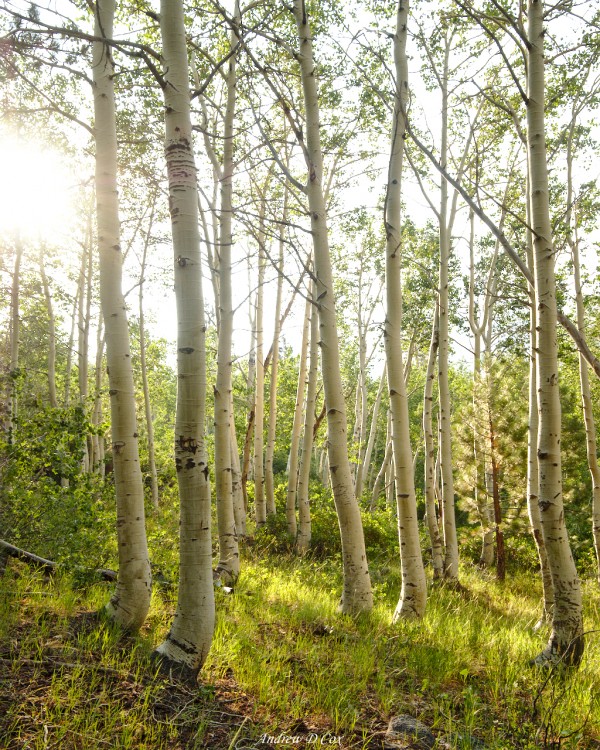
Once I’m satisfied with my aspen grove photo shoot, I continue up the JMT and do a little leapfrogging of my own. Matt and Darby like to eat breakfast on the road and are boiling water for their morning oatmeal next to the trail. As the morning hike progresses, we leapfrog each other several more times. Even though we’re not hiking together today and have different destinations, I really enjoy seeing their friendly faces every few hours.
Although the bright morning sunshine does wonders for my mood, it also burns my skin and increases my sweatiness. I suppose there are definitely perks to cool, rainy days. For example, I was incredibly comfortable ascending a few thousand feet to Bear Ridge in the gentle rainfall a couple days ago – much more comfortable than I would have been had it been sunny and warm! That being said, I certainly won’t complain about the sunshine after the damp, dreary weather I experienced yesterday.
At the east end of the canyon, the JMT ascends a long set of switchbacks named “The Golden Staircase.” Palisade Creek thunders down the slope nearby, offering a distraction from the long, uphill climb. I pause at several cascades during the climb to take some photos and experiment with a couple filters I brought along. During one such photographic break, a passing hiker takes a few minutes out of her day to chat with me about photography. She is also carrying a serious camera and I enjoy talking shop with her while my camera completes a few long exposures.
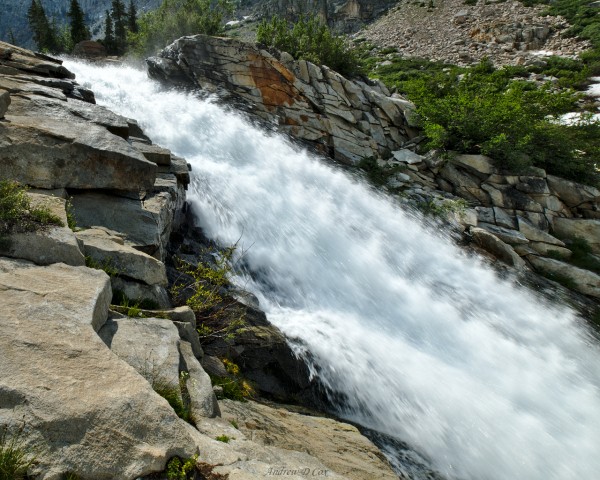
The next section of the trail meanders away from the creek and ascends a few hundred feet via short, steep switchbacks. I can see now why “staircase” is an appropriate name, much more so than the “Granite Staircase” Dad and I hiked a week ago. I’m not sure where the “golden” part of the name comes from; the warm light just before sunset would illuminate this stretch of trail beautifully, so perhaps that’s the reason.
On the way up the switchbacks, I notice a particularly wide cascade running down the opposite canyon wall. There is a nice granite outcropping with a few of the falls a few minutes’ walk from here, so I venture over to get a better view and take some photos. The vantage point isn’t as good as I would like – I think the image would work better shot with a long lens from farther away – but I enjoy the field trip nonetheless.
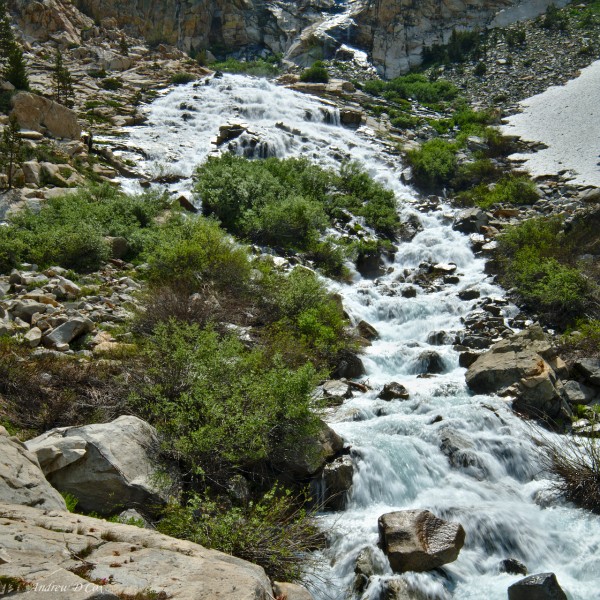
After scrambling back up to the trail, I continue climbing the never-ending switchbacks. With every hill I crest, I hope to glimpse the lower Palisade Lake but instead only see more switchbacks… the golden staircase goes on and on. The final few hundred yards include several small snowfields and some neat cliff-side walks above the churning waters of Palisade Creek. Finally, I see the glittering waters of Palisade Lake in front of me and hurry forward, eager for a rest. After a much-needed bathroom break, I pull out some peanut butter, dried fruit, and a tortilla and settle down to an equally-needed lunch.
Darby and Matt join me several minutes later. As we eat and chat, the sun slips behind a cloud. Without the warm infrared radiation, I’m suddenly quite chilly. A glance at the sky reveals a thick layer of clouds in every direction, something I didn’t notice while struggling up the switchbacks. I was planning on jumping in this lake to wash some of the sweat and grime off my body, but that doesn’t seem like a viable option anymore; swimming in these cold waters isn’t very fun if you can’t warm up in the sun afterward.
Once I’ve finished eating, I gather up my things, say goodbye to Darby and Matt, and continue up the trail. I don’t make it too far before being distracted by a lovely bouquet of shooting stars growing next to the path. To capture a shot of the flowers with the lake in the background, I lie down on the soft grass and wiggle forward until the blossoms are framed properly. After snapping a few shots, I’m tempted to remain on the grass; it’s soft and comfortable… but I’d better find a campsite soon; it looks like it’s going to rain again.
I hike further up the trail, all the while gaining altitude above the lakes. Along the way, I cross several small waterfalls splashing down from hidden pools beneath the Palisades. When researching this trip, I heard this area described as some sort of fairyland, with waterfalls dropping from high cliffs, sparkling lakes, beautiful trees and flowers – like Rivendell from the Lord of the Rings. I wouldn’t go quite that far in my description. Perhaps this area is more breathtaking at a different time of the year.
As I trek along above Upper Palisade Lake, I reach several campsites nestled among pines and massive granite boulders. The clouds are beginning to descend and obscure the peaks surrounding the Palisade Lakes, just like they did at Evolution Lake. Wary of the potential for rain, I’m careful to select a site that is level but not bowl-shaped. The last thing I want is to pitch my tent in an area that is going to collect water.
With a decent site selected, I unpack my gear and set up the tent. To ensure any water flowing down from above avoids my tent, I build a small wall of rocks and loose gravel on the uphill side and dig shallow trenches around the edges of my tent. If the tiny canals work like I think they will, all the water flowing down the hill and off the rain fly will be guided into the canals and trickle around my tent toward the downhill slope.
Satisfied with my work, I separate my scented gear from the rest, stow the scented items in the bear can not too far from camp, and then wander off to explore the area. The country above my campsite looks passable and the map hints at several high-altitude lakes in cirques beneath the lofty peaks. I imagine being out on Roper’s Sierra High Route and set off across the wild meadows toward the Palisades. As I scramble up a stretch of refrigerator-sized scree, a light rain begins to fall. At first, I push on but soon head for cover under an overhang on a nearby cliff. From this sheltered location, I watch the rain for a few minutes.
The precipitation soon dies out and I continue up the hill, excited to see what the wild backcountry has to offer. Only a few minutes later, it begins to rain again. This time I think twice about my plan. Here I am, climbing higher into the mountains while the weather degrades. There’s no saying what is coming next; it might continue to drizzle, or lightning may begin to fly. With a sigh, I turn around and carefully climb down the wet scree to gentler slopes. As I make my way back toward my tent, the rain turns into hail! The ground is soon covered with a dusting of pea-sized ice pellets and I’m thoroughly convinced that hiding out in my tent is the best option.
Back at my tent, I take off my shoes and socks and leave them in the vestibule beneath the rain fly. Before long, the hail turns back to rain and I hear thunder in the distance. I hope Matt and Darby are ok! Getting caught in a thunderstorm while traversing a pass is one of the most dangerous situations you can find yourself in out here. With any luck, they’ve made it over Mather Pass and have descended back to treeline on the other side.
I lay on my back in the tent, thankful to be comfortable and dry, but a little bored. It’s only 15:30 and I had planned on spending the afternoon exploring and indulging in some photography. There are still five hours of daylight left… I hope it doesn’t rain all night like it did at Evolution Lake. To kill some time, I dig my cell phone out of my pack and open up the podcast app. Anticipating a little boredom, I downloaded a bunch of interesting podcasts before leaving Mammoth Lakes last week. Good thinking, I think to myself and start up an episode of Freakonomics. I enjoy Stephen Dubner’s entertaining show for several hours before venturing outside to stretch my legs. The thunder has stopped, but the rain continues and everything more than a hundred yards away is obscured in mist. I seem to be inside the cloud layer up here.
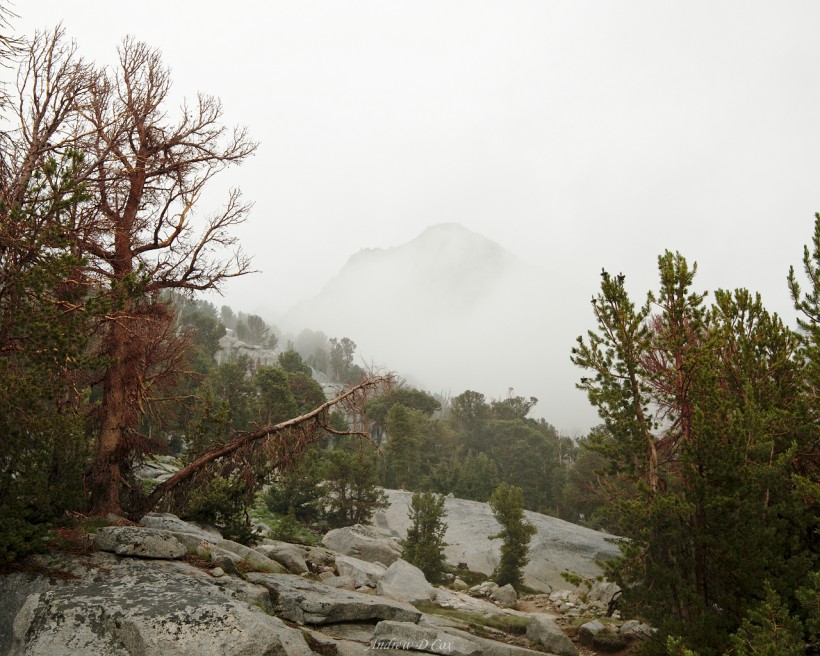
By 18:30, the rain has died down to a light drizzle and I escape the confines of the tent to make dinner. I bring a cup and a half of treated lake water to a near boil on the stove and then pour it into the freezer ziplock bag that contains my dehydrated meal. After resealing the bag and storing it in a homemade pot cozy, I wander away for to survey the landscape. It’s still quite misty, but the distant mountains are now faintly visible and the clouds seem to be rising, encouraging signs that the rain might be over for tonight!
I return to camp and eat dinner while watching the low-hanging clouds fly by, seemingly just above my head. Once I’ve finished eating, I put away my cooking gear, retrieve my camera from my tent and hike down toward Palisade Lake in search of a nice composition. I eventually find a decent view from a flat rock beneath a large conifer and set up my tripod to wait for sunset. I’m not too optimistic about the prospects of a colorful sunset, but I’ve predicted color incorrectly so many times that I’m not about to miss the shot if an opportunity does present itself.

Unfortunately, my premonition is correct and the skies never really light up. However, just before the skies begin to darken, the clouds above the lake – now at much higher altitudes – glow with a tinge of pink. It’s a beautiful, subtle sunset after a dreary, rainy afternoon. Satisfied and convinced there is no more color to be photographed, I clamber back up the steep slope to my campsite and crawl back into the tent.
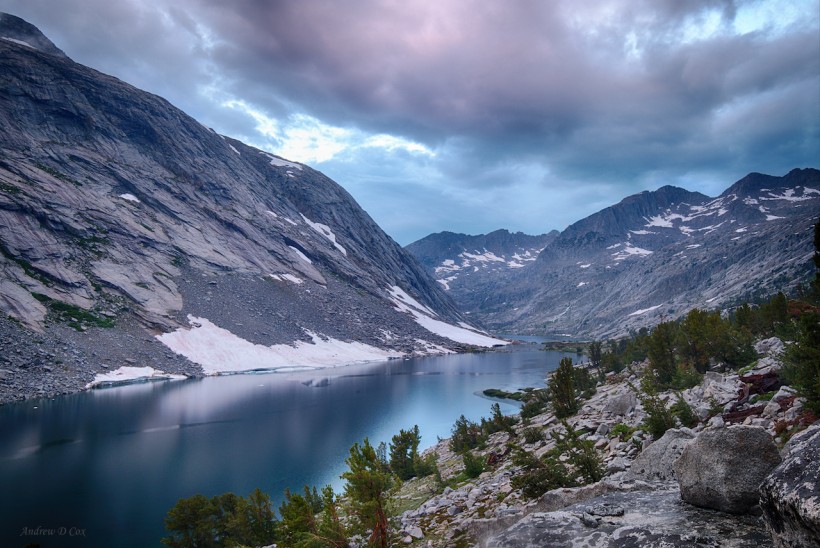
I’m surprisingly tired considering I spent most of the afternoon lying on my sleeping bag listening to podcasts. After a brief planning session for tomorrow’s adventures, I wiggle into my sleeping bag and drift off to sleep.
Two-Pass Day
August 6, 2017 | 14.6 mi | +3300 ft / -3300 ft | View On Map
Thanks to a restful day yesterday and an early bedtime, I wake at first light and am eager to move on down the trail. I stuff my wet tent into a garbage bag and then enjoy a large serving of overnight oats. Soon I’m striding down the John Muir Trail, slowly gaining altitude as the path winds around Upper Palisade Lake. Like the section before Muir Pass, the trail here is frequently filled with run-off from snow banks on nearby slopes. However, my shoes are more or less dry this morning, so I take care to avoid stepping in any deep water as I hike.
Although the sun is up, the trail remains in the shadow of the main Sierra crest. The uphill grade keeps my muscles working hard and the cold morning air feels wonderful as I huff and puff up the trail. Soon, I reach switchbacks that climb more aggressively toward the pass (12,100′) and leave the greenery behind. The landscape is dominated by stone and icy snow up here, and only the occasional wildflower growing on the side of the trail gives any indication that life is possible in such a harsh environment.
Large snowfields blanket the slopes ahead of me and I have no choice but to cross them to reach Mather Pass. I cautiously step out onto one of the several clear sets of boot tracks that mark the popular routes across the snow. Due to the early hour and the lack of direct sunlight (and probably also yesterday’s rain), the snow is rock solid and slippery as can be. I’m able to stab my trekking poles an inch or two into the surface and carefully – very, very carefully – step from one sunken boot print to another. I’m aware that this is a very risky idea; a slip on this traverse will result in my sliding a hundred feet down the hill into a lot of sharp rocks. I have no traction devices and no tools to self-arrest with other than my poles,.
I continue regardless of the danger and focus on careful foot placement. Soon, I reach the other side of the snowfield and take a short break on a pile of scree. The trail is nowhere to be seen amidst the snow and rock, so I scramble up the loose stone slope to the next set of boot prints in another snowfield. After several more slow, cautious traverses, I reach the trail and resume a much safer trek to the top of the pass.
As I crest the saddle, I finally escape the shadow of the eastern ridge and step into the bright sunlight. I pause and bask in the warm morning rays for a moment. It’s amazing how much of a difference direct light makes in terms of both temperature and mood; I haven’t felt the sun since lunchtime yesterday! To commemorate reaching the top of Mather Pass, I set up the tripod and take a “selfie” with a view to the south. I can’t be sure, but I’m willing to bet that I’m the first person up here today!
After enjoying the view, I pull my pack on, buckle up, and walk across the saddle to the trail on the south side. Thankfully, this side of the pass has already soaked up the sun for an hour or two and the little snow that bars my path is soft and easy to walk across. The trail descends rapidly via a set of switchbacks for about 400′ and then levels off on a beautiful alpine plateau. The path stretches out in front of me, winding through the barren landscape for as far as the eye can see. Imposing granite mountains line the horizon and a few small lakes reflect the snow-clad peaks. This, my friends, is heaven on earth.
The distant mountains grow larger as I stroll down the smooth gravel trail. The lack of obstacles on the ground means my eyes are free to take in the beautiful scenery. The barren landscape soon gives way to more greenery and I continue down the path with a huge grin on my face.
To my great satisfaction, the alpine landscape persists for several miles. As I descend, the grassy plains give way to clumps of stunted trees and then a forest of taller pines. I cross at least 8 creeks in the next seven miles. Most require a short wade, for which I remove my shoes and socks every time (dry shoes!), but I’m able to ford a few via rocks or logs. Each of these streams flows into the South Fork of the Kings River, which I’ll have to ford today as well. The official John Muir Trail crossing of the Kings is a few miles downstream but is incredibly dangerous right now. Before I began hiking, at least one person died attempting to cross there and, in the time since I began my trek, at least one other hiker has drowned at the same location. Due to these tragedies, an alternate route has been devised and I’ll cross the Kings River within the next mile where the many tributaries can be crossed individually.
It isn’t long before I reach a makeshift sign tied to a tree next to the trail marking the alternate crossing location. A few hikers are camped next to the river just below the trail so I walk down to say hello. As I get closer, I realize the hikers are Matt and Darby! I’m glad to see them and ask how they fared yesterday afternoon. They report that they were caught in the rain/hail/thunderstorm as they descended this side of Mather Pass; I can only imagine their haste to lose altitude and avoid the lightning. They’re enjoying a lazy day after that excitement, and are planning on exiting the trail over Kearsarge Pass to resupply in a few days, so I probably won’t see them again. I wish them good luck with the rest of their hike and then wade through the frigid Kings River just below their campsite.
On the opposite bank of the river, a well-worn use trail winds south, remaining close to the river bank. I enjoy the walk along the twisted, makeshift path through a section of forest that I’m sure receives very little foot traffic most of the time. I rejoin the John Muir Trail around noon, hot and hungry, and find a pleasant spot to stretch out and eat lunch. Before digging into my food, I unpack all my wet gear and drape the dripping nylon across sunny rocks to dry. My notes and paper itinerary are still wet from the afternoon downpour south of Muir Pass, so I carefully lay them out and place rocks on the edges to keep them from blowing away.
By the time I finish eating lunch, my gear is completely dry! I suppose I could get used to this schedule: rise early and get some miles in, then take a long break late in the morning to dry gear. If it rains in the afternoon, I can deal with that. I didn’t expect the rain to be so persistent and the continual dreariness a few days ago really affected my mood. However, now that I’ve adjusted my expectations and made peace with the fact that it might rain, I’m happy and eager to hike. Bring it on, mother nature!
I kid… please don’t!
Re-energized from lunch, I pack up my supplies, hoist my pack onto my back, and begin hiking once more. The trail wastes no time gaining 1000 feet and I’m soon sweating heavily as I trudge up switchbacks. My plan for the afternoon is to hike to Marjorie Lake, a mile or two short of Pinchot Pass. The map marks half a dozen campsites around the lake and I’m willing to bet it is gorgeous!
I soon arrive at Bench Lake and make a flying leap across the outlet stream (which I only barely make) before continuing up the trail. After my brief time in the upper montane forest this morning, I’m pleased to return to the sub-alpine zone even if there is less shade. I stride up the gentle slope and soon reach Lake Marjorie. My watch reads 14:00, and I’m on the lookout for an afternoon thunderstorm. I feel a few drops of rain as I explore the rocky hillsides around Lake Marjorie, but the rain holds off for the time being. There is not a single person here and, while the lake is lovely, I’m not particularly smitten. Few of the campsites offer any protection from rain or lightning as I’m only a few hundred feet below treeline here. I could retreat to the thicker trees around Bench Lake or… I could race the afternoon weather over Pinchot Pass and take my chances on the south side.
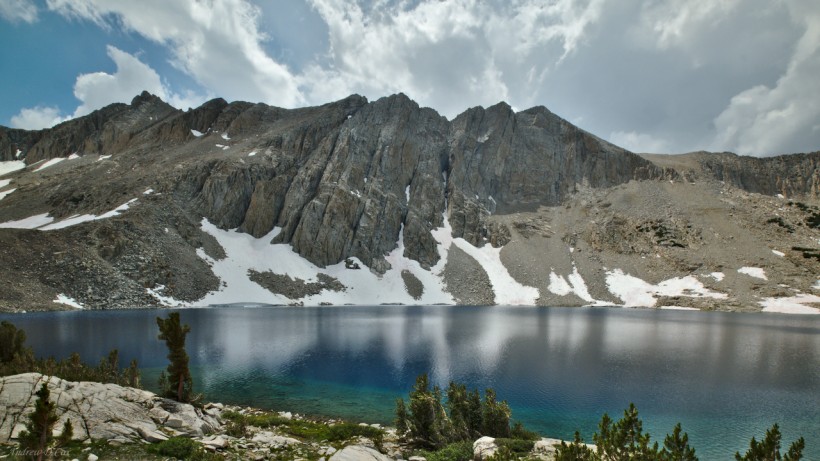
After arguing with myself for a few minutes, I decide to take my chances with Pinchot Pass and the country to the south. Is this the safest decision? Nope. Definitely not. But I’ve also noticed that there is a persistent patch of blue sky above the pass, which breaks the pattern I’ve observed during the past few days. Right before the rain comes, the clouds have been sinking lower and obscuring the mountain tops; there hasn’t been any blue sky visible during the storms of the past three days. So, while I’m aware that climbing higher in the face of a possible storm is a risk, I’m willing to bet that the rain is still at least an hour or two away. Pinchot Pass is less than 2 miles from Lake Marjorie, so I’m confident I can make it over well before the weather turns foul.
With one eye on the trail and another on the clouds above, I race toward Pinchot Pass. I haven’t walked this quickly since I had to retrieve my rope from Sallie Keyes Lake, and now I have a fully-loaded pack! Thankfully, the ascent to Pinchot Pass is much easier than Mather Pass was this morning. There is less snow, and the snow I do have to cross is soft and squishy. I reach the Pinchot Pass saddle before 15:00 and rest for a few moments to catch my breath from the hurried ascent. The patch of blue sky still exists above my head, though the clouds over Lake Marjorie are beginning to look dark.
With the impending storm looming behind me, I hurry down the south side of Pinchot Pass. Other than one or two tiny snow drifts in switchback corners, the descent is snow-free. The landscape in front of me looks remarkably like images I’ve seen of Iceland: a patchwork of green grass, dark red stone, and white snow. I pause to snap a few photos but don’t dare stop for too long; those ominous clouds are still building behind me!

I’m grateful to reach the bottom of the switchbacks; the steep descent is just as difficult to traverse as the steep uphill. I enjoy trekking through the colorful patchwork countryside and soon catch a glimpse of a valley with dozens of small lakes and tree-covered islands. It’s a beautiful valley and I would love to camp there, but I can’t see any flat spots from the trail up here. I’m sure I could find a nice campsite if I walked all the way down, but I’d rather continue along the trail. That patch of blue sky keeps moving around and the clouds don’t appear to be getting any lower or darker… maybe it won’t rain after all!
I trudge across several long snowfields above the lake-filled valley but still don’t spot any suitable campsites. My legs are beginning to ache from my hurried pace, but I’m not willing to slow down just yet. As I reach the first tributaries of Wood Creek, I finally spot a nice sandy area next to a small pond. The layer of dark clouds form a front almost directly overhead and the sun peeks around the edge to illuminate the pond and my campsite. I wonder if the dark clouds will advance and block out the light? Grateful for the prevailing sunshine, I struggle to set up my tent in the stiff breeze. The rope comes in handy again as the sandy soil is only an inch or two thick and I resort to tying the tent off to boulders.
Once I have camp all set up, I explore the area and gather some water from the headwaters of Woods Creek. While exploring, I discover a larger lake just a few hundred yards down the trail from my current campsite. A grove of large pine trees above the lake shelters a half dozen sites from the elements, and the lake itself is stunning. With plenty of daylight left, I hurry back to my campsite and pack up my things to move to the better location. It’s too bad I didn’t see that lake earlier… I could have saved myself a lot of effort!
Down at the larger lake, I enjoy a hot meal and spend the rest of the evening exploring the nearby wilderness. A family of deer – one buck, 2 does, and 2 fawns – graze in the marshy wetlands above the lake, occasionally glancing my way in curiosity. A dozen Steller’s Jays jabber loudly at one another in the trees and fight over pine cones. Their loud squawks are annoying at first but my brain soon filters them out as I grow used to the squabble.
At the outlet stream, I find a meadow strewn with white granite stones and pink shooting stars, and a magnificent view of Mount Clarence King to the south. I sit down in the soft grass and take several exposures to blend together when I get home. As I continue to explore and take photographs, the temperature steadily drops. I remain comfortable in my down puffy jacket, but only just; I do a little dancing in place to stay warm.
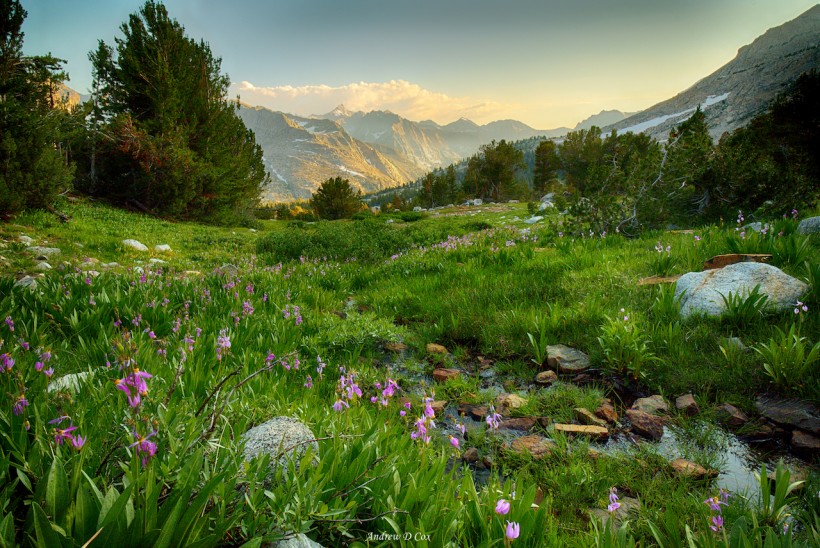
I linger until the color fades from the distant peaks and then trudge back to my tent. Several other hikers have pitched their tents nearby in the small pine grove, but are already bundled up in their tents. Pooped after the long day, I crawl into my own tent and relax. It didn’t rain today after all! With any luck, the rainy days are behind me.
I’m often asked what photography equipment I use to document trips like this one. On this particular adventure, I carried the Fuji X-T2 and Fujinon XF 10-24mm f/4 lens as well the Sirui T-024X carbon fiber tripod. See my dedicated gear post for a complete gear list.
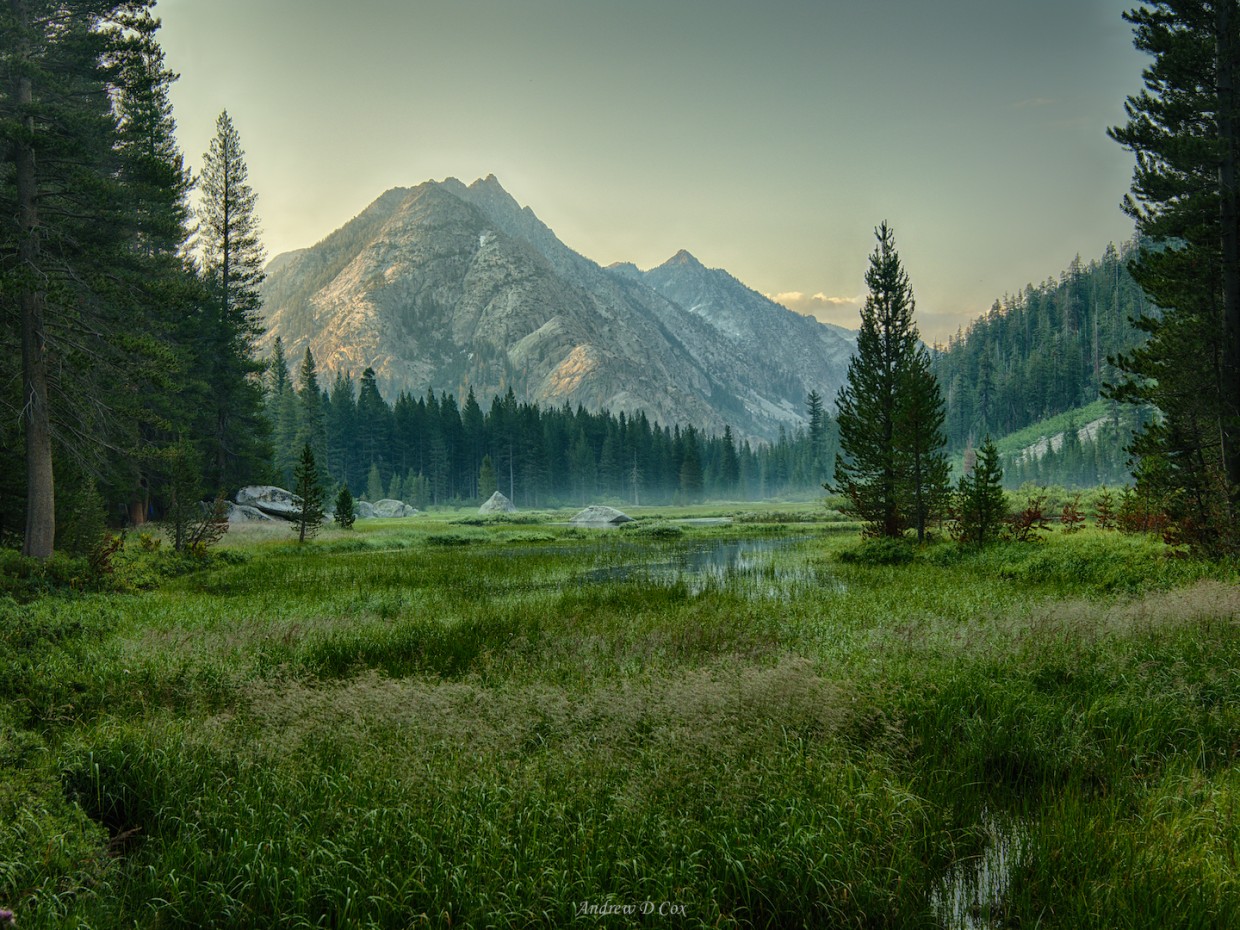
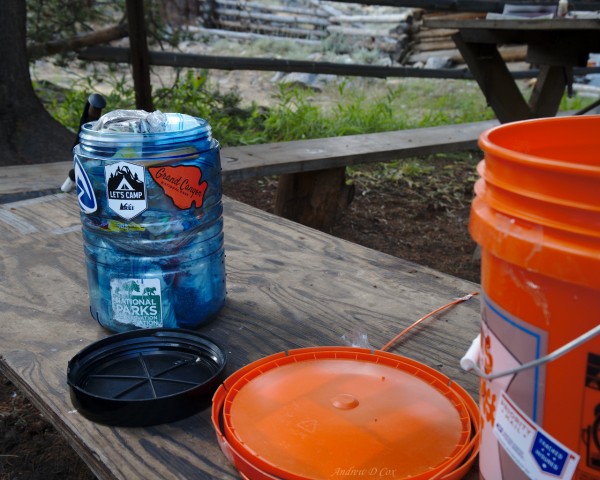
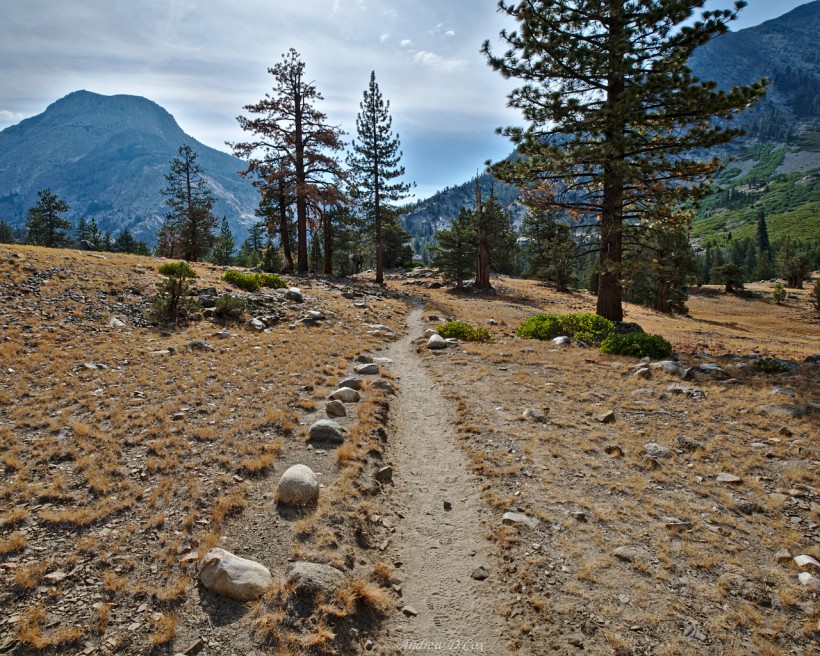

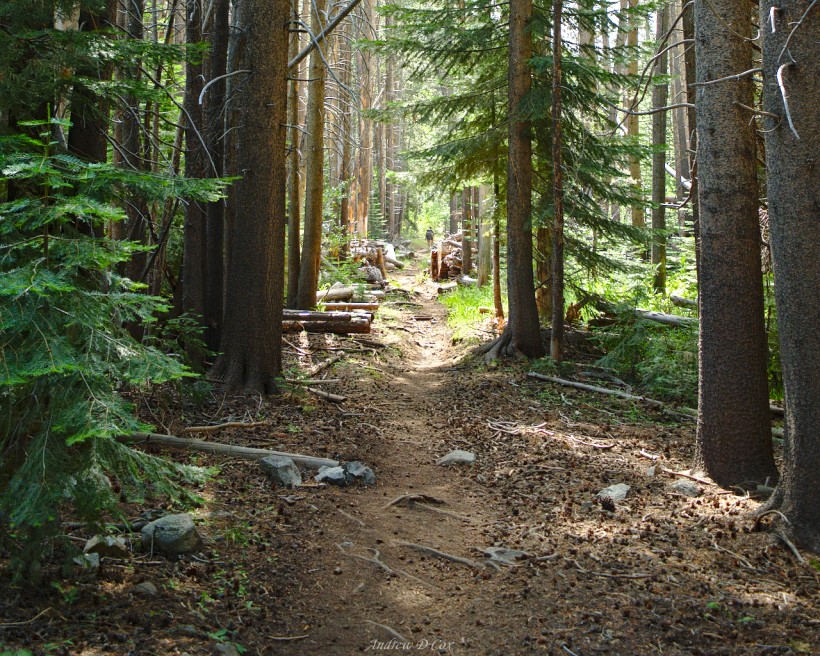
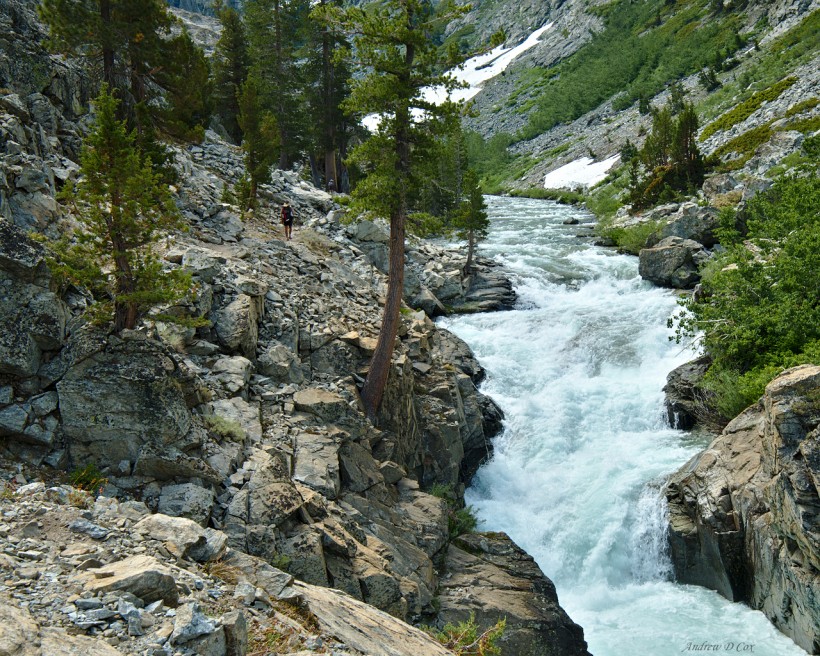
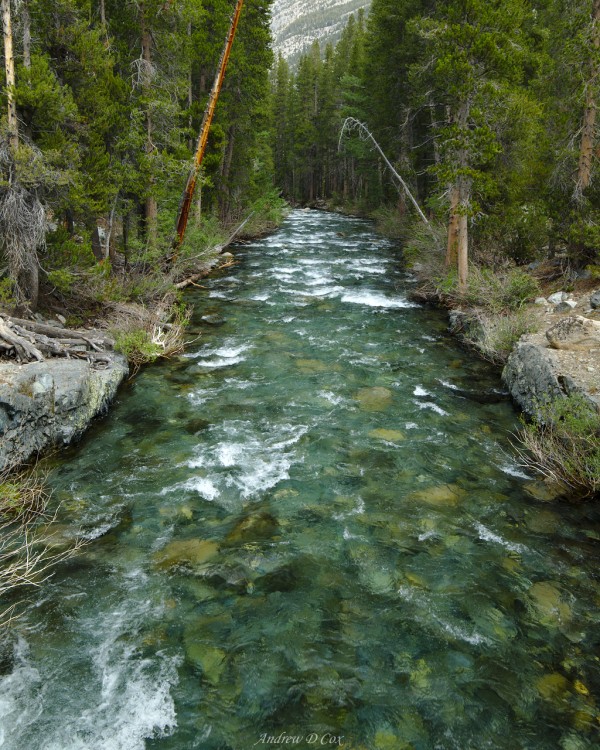





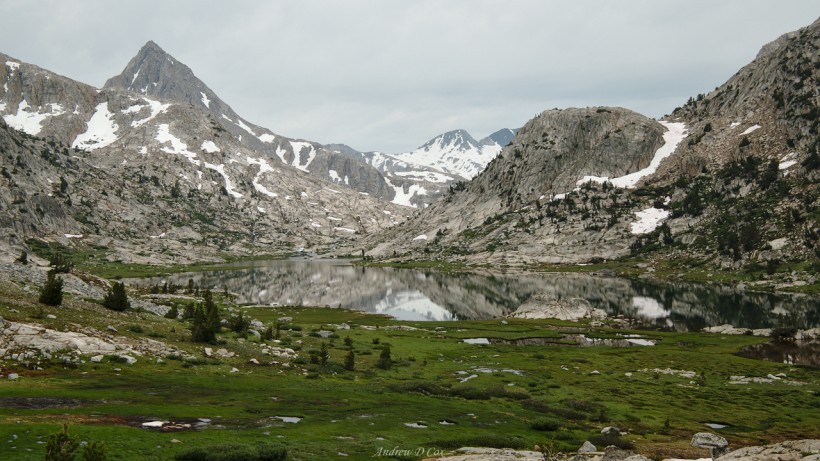
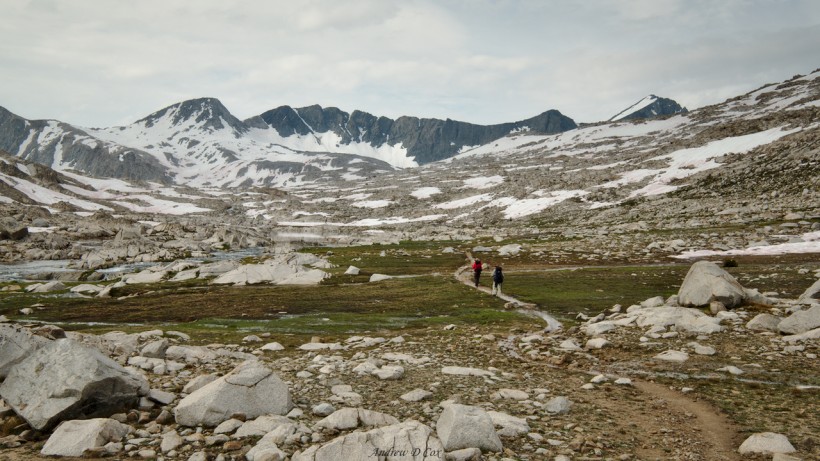

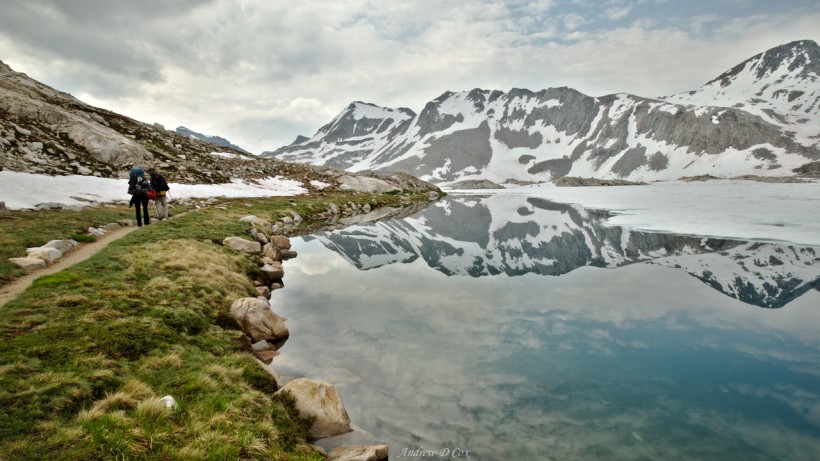
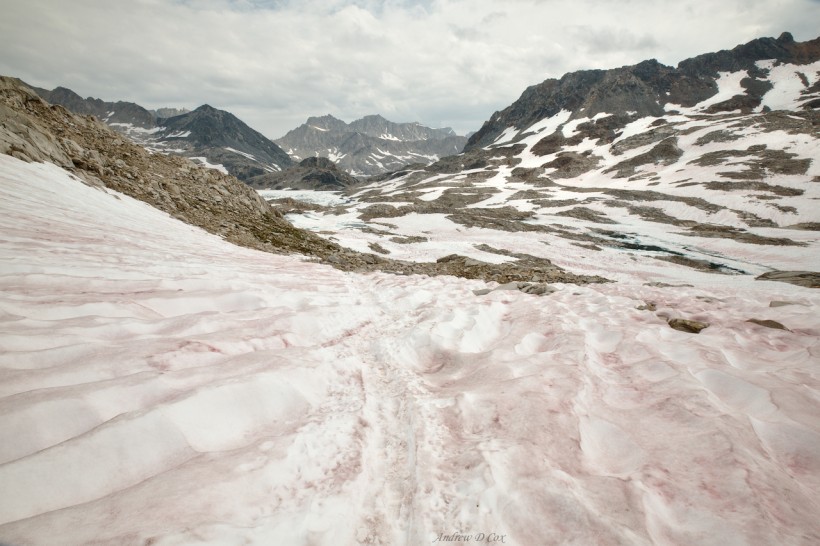
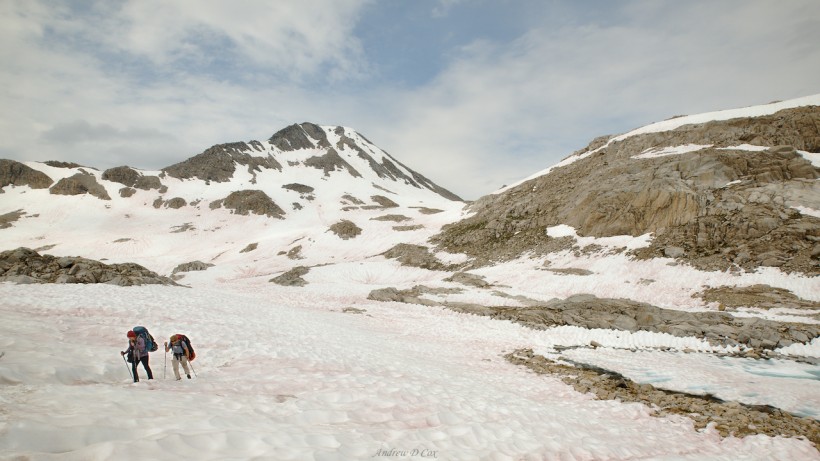
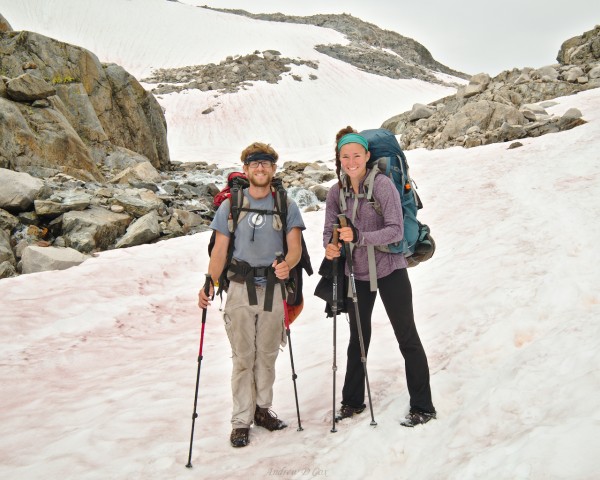
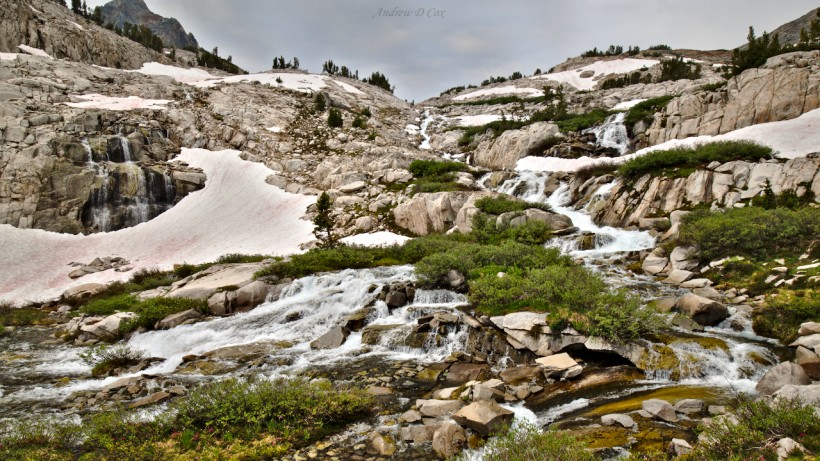
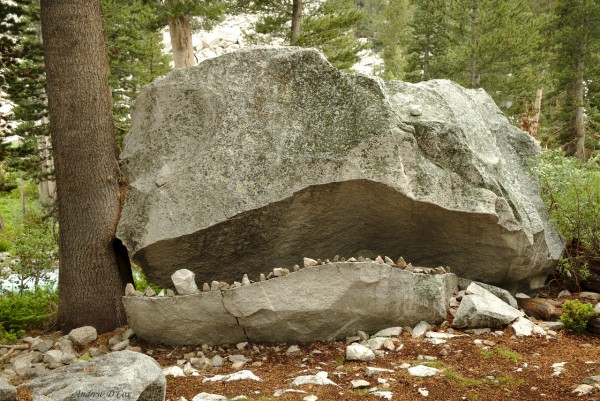
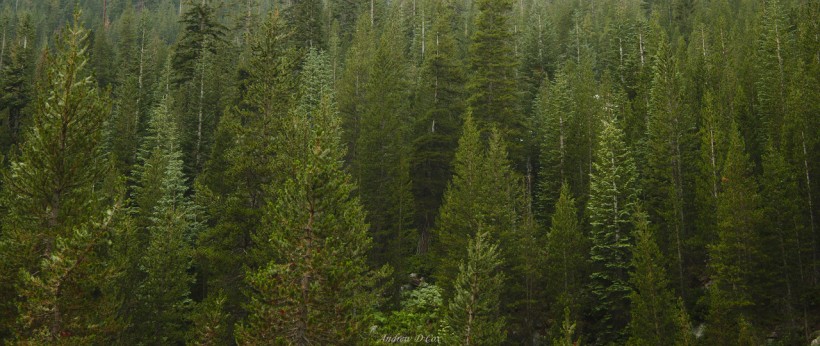
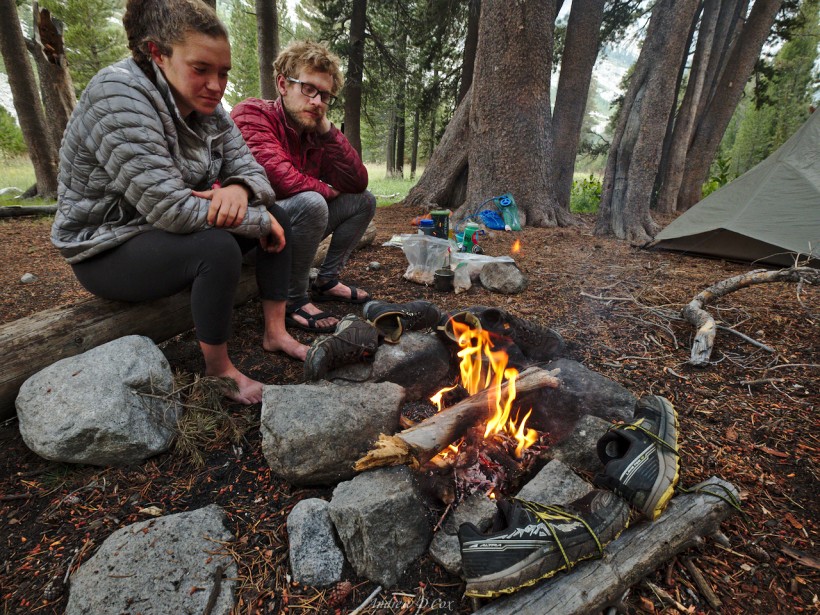




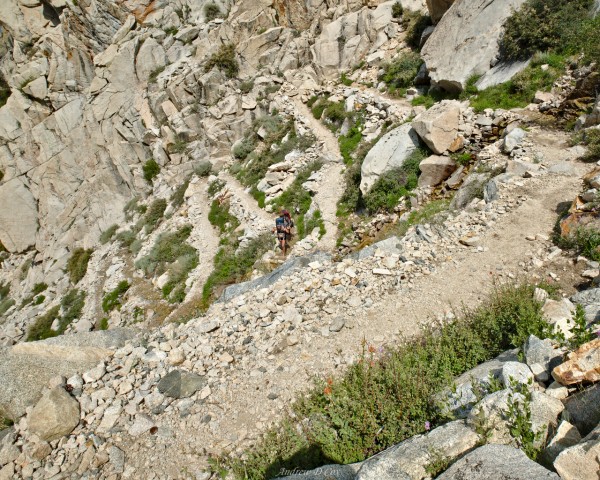

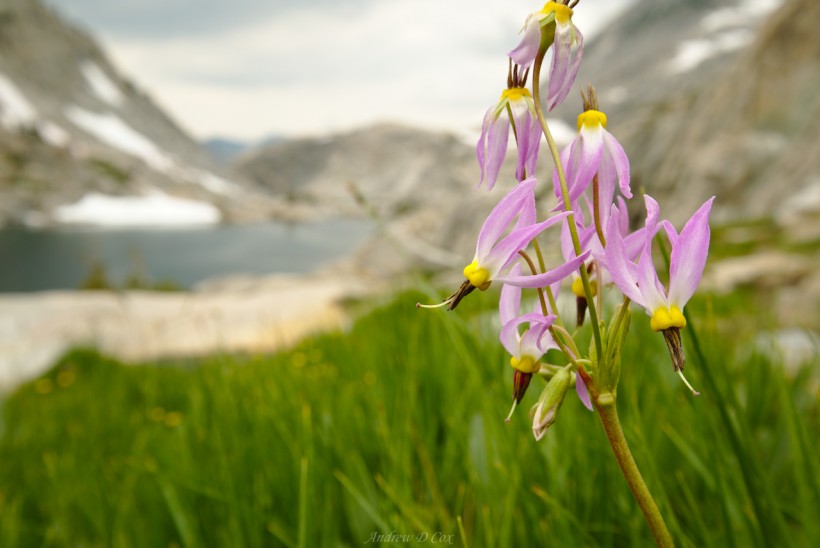

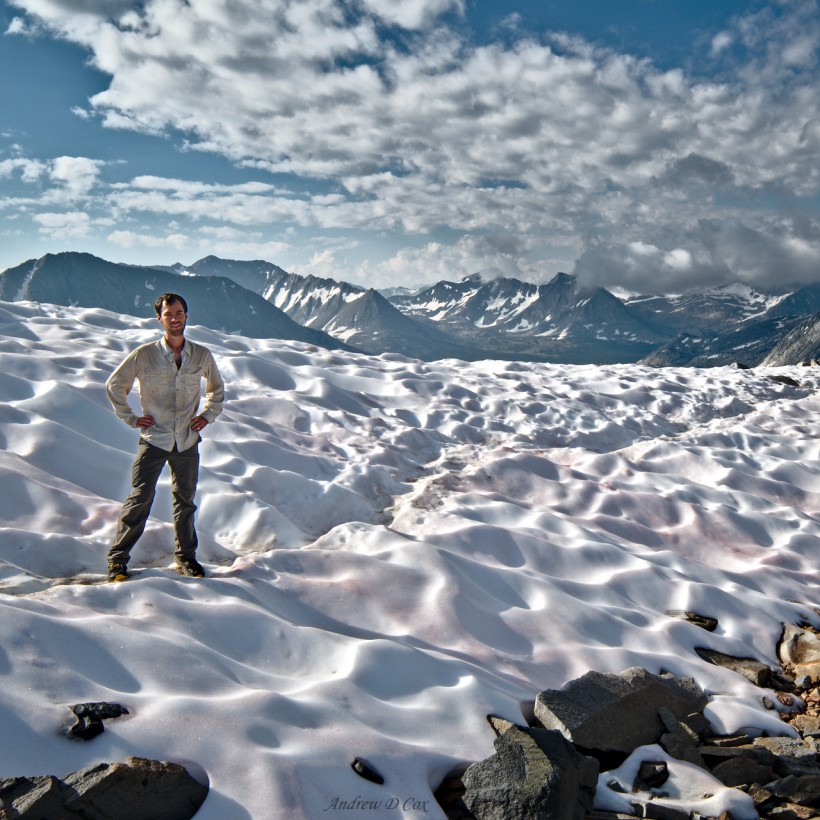
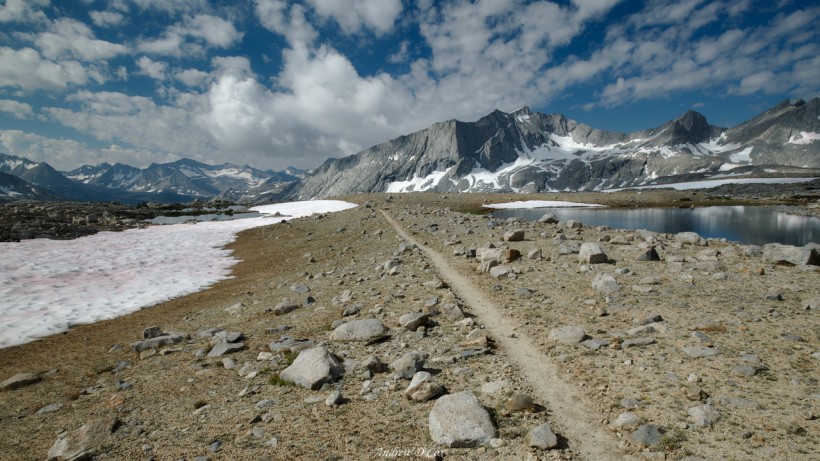
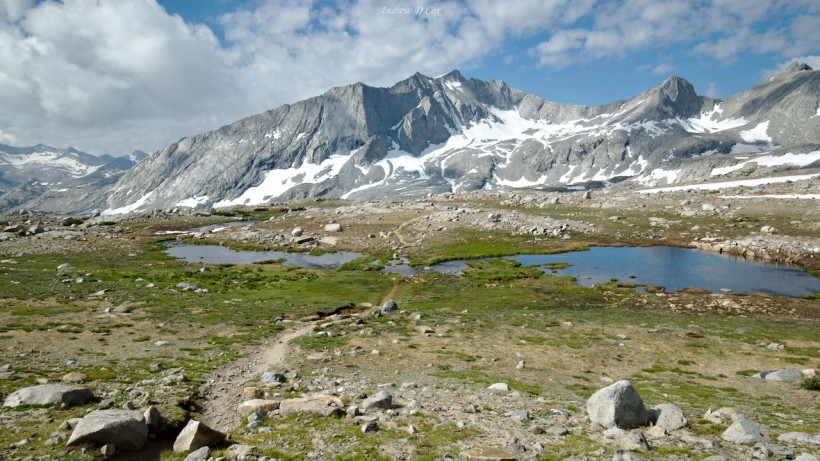
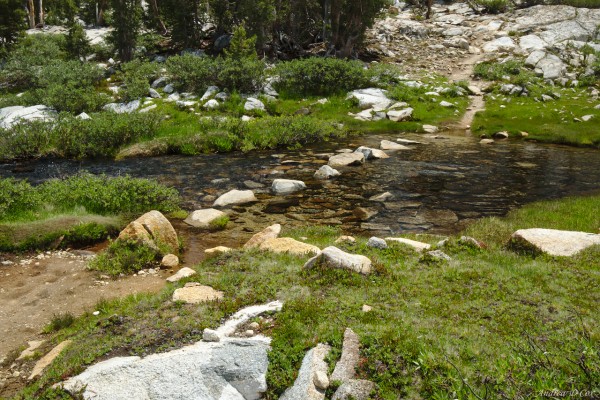
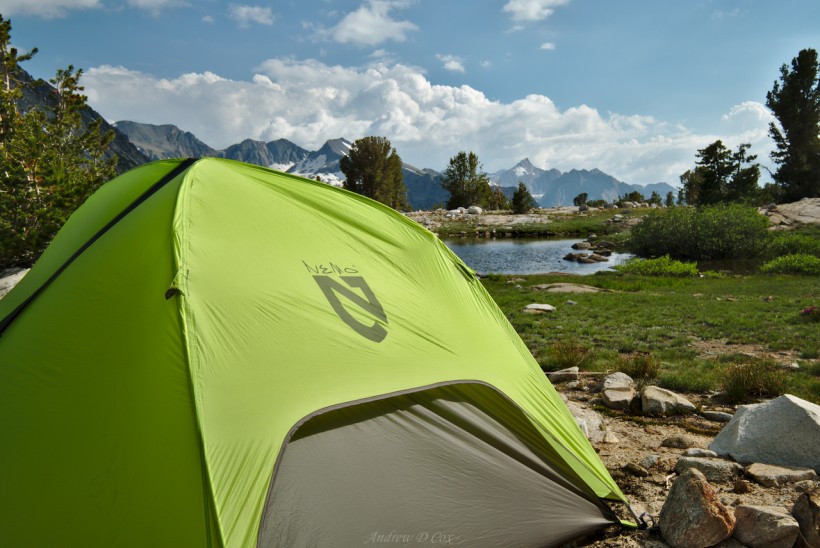
Thierry Arditti 7 January 2022
A Thousand thanks — Your unstopable JMT back country sights.
Regards,
Thierry
Diane 27 December 2023
Hi Andrew – This is really exceptional work.. not only are your photos about the best I’ve seen of the JMT, but also your write-up is fun to read. It really captures the practical details of the joys and challenges of day-to-day travel. I think my favourite pictures are those that you took when the weather was cloudy/ wet – there are endless pictures of the Sierras with blue skies on the web, but these are altogether different, and very lovely in their own way.